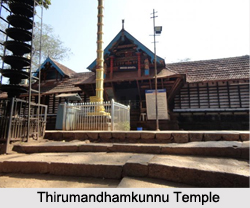 Thirumanthamkunnu Temple is dedicated to Thirumandhamkunnilamma who was the official goddess of the kings of Valluvanad, the local feudal kings who ruled the area in the middle ages. The assassins of Valluvanad king had set out from this temple to Thirunavaya in order to participate in the famous Mamankam festival. A memorial structure known as the chaver thara is found in front of the main entrance of the Thirumanthamkunnu Temple.
Thirumanthamkunnu Temple is dedicated to Thirumandhamkunnilamma who was the official goddess of the kings of Valluvanad, the local feudal kings who ruled the area in the middle ages. The assassins of Valluvanad king had set out from this temple to Thirunavaya in order to participate in the famous Mamankam festival. A memorial structure known as the chaver thara is found in front of the main entrance of the Thirumanthamkunnu Temple.
The temple is a major pilgrimage for the eleven-day long annual festival that is celebrated in March and April months. The standard deity of temple is Lord Shiva. Other deities worshipped in this temple include Thirumandhamkunnilamma and the elephant god Lord Ganesha. The important religious offerings of Thirumanthamkunnu Temple are Mangalya Puja, Rigveda Laksharchana, Chandattam and Kalampattu. The Thirumanthamkunnu Temple courtyards are on a hilltop.
Legend of Thirumanthamkunnu Temple
The King of Surya dynasty King Mandhata ruled his kingdom for long period. He gave away the kingdom to his successors and chose to meditate on Lord Shiva and attain the Shiva`s feets at the end. Lord was pleased and appeared before the king Mandhata and offered him any boon at Mount Kailash. The king prayed to the lord for an idol in order to worship till his death. Shiva gave him the most religious Shiva Lingam which used to be worshiped by Goddess Parvati and then God disappeared. Lord Shiva had gifted that Lingam when his companion Parvati had gone for bath.
He carried Shiva Lingam on his head and started his journey downward from Kailash Mountains and reached the "Thirumandhamkunnu" hill in Kerala. As his head was feeling heavy, he placed it on the ground and it got stuck in to the earth. When Parvati came back to worship Shiva Lingam was not there. She was upset when she came to know that it was presented to the King Mandhata by her husband. She wanted the Shiva Lingam back as she was very attached to it. Shiva had no objection in her trying to get it back. Parvati sent Bhadrakali and other demons to get back the Shiva Lingam from the king. Bhadrakali reached the northern slope of Thirumandha hill along with the demons. The brightness of that Shiva Lingam dazzled the eyes of Bhadrakali and demons and they were unable to move up the hill. They started throwing up the weapons from the foot of the hill. They were unarmed so they plucked Attanga nuts from their creeper plants which were available in plenty and threw them at the enemy. The nuts changed into arrows due to the power of Shiva. The battle lasted for fifteen days.
Bhadrakali took the viswaroopa form. She had an elephant in an ear and a lion in the other. The ascetics seeing this form fell down senseless. Mandhata was also helpless. He embraced the sivalinga. In this struggle the linga got split into two. In the "Jyothis" that arose from it Lord Brahma, Lord Vishnu and Siva and Parvati appeared on the spot. Parvathi entered that Linga and this spot is known as Sreemoolasthanam. The shiva is in a split condition here. The position of Shiva Linga is below the "peedam" and "Prabhamandalam" and can be seen during the abhisheka before the usha pooja and "Malarnivedia" that is offered to the deity.
Bhagavathi with Sapthamathrukkal, Veerabhadran and Ganapati were installed facing north which is called "Mathrusala". When Goddess Parvati had appeared infant Ganapathi was also with her. Thus he was also installed at sreemoolasthanam.





















